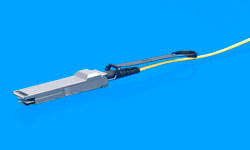Silicon Photonics Fills Significant Gap In Data Center Connections
 It is difficult to overestimate the impact of the emergence of the Cloud on everything from equipment design to network construction, but one physical impact is that data centers are becoming larger and more distributed. One increasingly common challenge is that in many cases physical constraints make it impossible to keep expanded data center capacity in the same building or floor. So, in many cases as Cloud Services Providers expand, they find the need to increase capacity in adjacent buildings or different floors.
It is difficult to overestimate the impact of the emergence of the Cloud on everything from equipment design to network construction, but one physical impact is that data centers are becoming larger and more distributed. One increasingly common challenge is that in many cases physical constraints make it impossible to keep expanded data center capacity in the same building or floor. So, in many cases as Cloud Services Providers expand, they find the need to increase capacity in adjacent buildings or different floors.
All of this leads to a new technical challenge: the need for longer links to economically interconnect larger data centers, and data centers that may be constructed as pods or clusters distributed across a campus. Molex singlemode silicon photonics is uniquely suited to address this challenge: it has reach of up to 4KM at the same level of power consumption and cost as distance constrained VCSEL based optics.
First, a quick synopsis of the current options available to data center designers. Currently data center designers essentially have two optical interconnect options: short reach (SR) and long reach (LR). The problem is that SR optics (or traditional VCSEL based optics) are limited in the distance they can transmit. That limit is generally accepted at 300 meters, and many product offerings can only go 100 meters and in some cases even down to 50. They offer a significant advantage over copper interconnects, but are now suffering the same problems copper interconnect had: as data transmission speeds increase, the distances that can be run are getting shorter and shorter. Yes, some of that impact can be mitigated by installing (yet another) fiber upgrade to OM4. However, network designers are getting weary of very expensive and difficult to implement structured cabling upgrades as speeds continue to increase. In short, SR optics have increasing limitations as distances and speeds increase.
The other option to fill the distance gap has been long reach (LR) optics. They function very well, but because they are designed for very long distances (100KM and higher) they are both very costly and use lots of power. Cost and power consumption are the serious issues in data center design, so that solution is not really viable.
The market has been seeking a third option, and Molex single mode silicon photonics base active optics are uniquely positioned to satisfy this growing market requirement.
Molex silicon photonics based products offer five primary advantages:
- Distance: Molex singlemode silicon photonics AOC’s transmit up to 4KM. This can accommodate most, if not all, new data center requirements.
- Power: Silicon photonics based AOC’s use basically the same power consumption as VCSEL based products: under 1W for a 56G QSFP+ AOC.
- Cost: Cost is roughly the same as VCSEL based AOC’s, but as they are singlemode they use much less expensive SM cable as a transmission medium. As VCSEL based product speeds increase, they require ever more expensive types of fiber to transmit effectively. After most networks have upgraded to OM3, another upgrade to OM4 has serious cost implications. And, what comes after OM4, and how soon will it be needed? With SM silicon photonics AOCs the fiber stays inexpensive singlemode – and stays the same as speeds increase.
- Future-proof structured cabling. This is becoming an increasingly important factor in driving the adoption of silicon photonics in the market. New installations in particular want to design in structured cabling that is future proof. It is no longer economically viable to keep upgrading fiber as speeds continue to increase. Singlemode fiber can accommodate the next generation of 25Gb, 50Gb, 100Gb and higher. Singlemode has additional advantages in that it can accommodate various CWDM and DWDM options that may be implemented. Installing SM today can accommodate the broadest range of options for the future.
- Pigtail version for easy connection and upgrade. Molex offers Pigtails: one end a traditional QSFP+ active side, and the other either MPO or LC’s. This enables a quick connection to structured cabling (so the AOC side doesn’t have to be pulled long distances) and the ability to quickly upgrade to new products as the need arises. So, when the 4 x 28G zQSFP product is introduced, it can be immediately connected to structured cabling already in place. In a minute you can upgrade from 10GbE or 40GbE to 100GbE!

Molex – QSFP AOC Pigtail Fiber
As someone who spent the 90’s working with high speed copper interconnects, I remember all of the technical challenges (ongoing today) of finding new and exotic ways to increase the distances and speeds copper interconnects could handle. At the time, fiber optics were viewed as the option for handling higher speeds and longer distance requirements. Few predicted that traditional VCSEL based optics would begin to experience some of the same challenges as copper interconnects did over a decade ago, and yet, that time is here.
Singlemode silicon photonics bridges the gaps caused by the dual requirements of being able to handle longer distances and accommodate higher data transmission speeds. For many customers this technology provides lower cost, lower power option for what can be referred to as medium reach (MR) distances, and provides a solution that is future proof for next generations of data transmission speeds. And at Molex, that technology is available today.